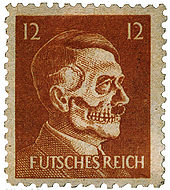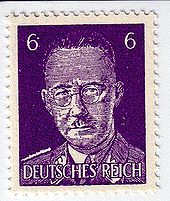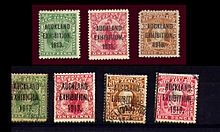- Philatelic fakes and forgeries
-
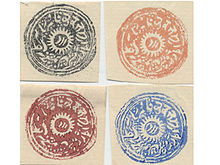 "Brighton forgeries" of the stamps of Jammu and Kashmir produced by Harold Treherne.
"Brighton forgeries" of the stamps of Jammu and Kashmir produced by Harold Treherne.
In general, philatelic fakes and forgeries refers to labels that look like postage stamps but are not. Most have been produced to deceive or defraud. Learning to identify these can be a challenging branch of philately.
To a large extent the definitions below are consistent with those given in the introduction to various recent editions of the Scott Standard Postage Stamp Catalogue. "We use the term "forgery" to indicate stamps produced to defraud collectors (properly known as forgeries) and to defraud stamp-issuing governments (properly known as counterfeits). "Fake" is used to indicate the alteration of a genuine stamp to make it appear as something else. Fakes might refer to cancels, overprints, added or clipped perforations, stamp design alterations, etc." [1] Although some philatelists stick to precise definitions of these terms, one should not assume that this is the case with every writer.
Questions are often raised about when a stamp is legitimately produced for postage. The following quotation may be helpful:
“ Stamps are legitimate if they are recognized internationally in practice, even if they are not recognized expressly, as by a treaty or international agreement. This is the same principle of international law that applies to the recognition of nation-states. A nation becomes a nation-state when the international community begins treating it as such. For Karabagh which is not a member of the UPU but which does get its mail delivered, this demonstrate that the stamps it issues are neither propaganda labels nor part of a money-making scam.[2] ” Contents
History of philatelic fakes and forgeries
The first postage stamp was issued in Great Britain in 1840, and by the early 1860s or earlier the first postage stamp forgery [3] -- in the sense of a stamp created to fool philatelists into thinking that it is a genuine one—appeared on the market. By 1863 forgeries were so common that the book Forged Stamps: How to Detect Them was published[4] and by 1864, forgeries were being produced of both common and scarce stamps from a wide range of issuing countries such as Austria, British Guiana, Finland, India and Spain.[5]
Jean de Sperati is among the master forgers in the history of philately. The Vancouver Island forgery refers to a stamp that was originally issued in 1865. To produce his forgery, de Sperati bleached a real, cheaper stamp of the same vintage. He then used a process called photolithography to make an almost perfect copy of the stamp. In his lifetime, Jean de Sperati forged over 500 stamps. He sometimes signed his work in pencil on the back. His forged stamps are now often worth more than the originals.[6]
Classification
Stamp-like objects, not all of which are really fakes and forgeries, are described below for the sake of developing a better understanding of such claims.
Postal forgeries or counterfeits
Those who produce counterfeits appeal to a very different market than philatelists. They depend on their stamps being produced in large quantities in order to be able to recover their investment. The person who would use them must feel that he can purchase them for a price that is significantly lower than what he would pay at a legitimate post office. This makes the most common current stamp used for everyday mailing a prime target for counterfeiting activity.
The earliest forgeries are all postal, and the Penny Black was the first stamp to be copied already in its first year in 1840.[7] Partial forgery consists of changing colors or changing the numericals of stamps to imitate a higher value stamp. Other tricks consisted of methods to make the marker disappear (chemically erasing, placing a second stamp on it if it just hits a corner. The Spanish Post Office had to change its stamps almost annually between 1850 to 1879 to stay ahead of the forgers.[7]
Notable postal forgeries include:[7]
- France: 20c (1870), 15c (1886), sower 25c (1923)
- Germany: 10pf (1902), 10pf (1909)
- Great Britain: 1s (1872), 4d World Cup Winners (1966)
- Australia: 2d Sydney Harbour Bridge (1932)
- USA: 13c Liberty Bell (1980)
As a curiosity postal authorities have published their own forgeries, thus the British Post Office forged its own 1d stamps in 1856 to see if its features were fraud-proof.
Protective measures
Postal services developed early on measures to protect the integrity of their stamps. Some of these steps are similar as used to protects against forged currency. Major steps include:
- Watermarks
- Special paper
- Delicate engraving
- Printing methods
- Special ink for post marks
- Insertion of silk threads
- Secret marks either visible or invisible to the microscope
- Re-issue of stamps
It may not be possible to distinguish between a philatelic and postal forgery if the stamps are unused merely by looking at them; the techniques utilized in producing them are identical. However, if the stamps bear cancellations, they may be more readily distinguished. If a stamp has a forged cancellation, it necessarily is a philatelic forgery since it was obviously made for sale to collectors, not to be used to send a letter.[8] If the cancellation is genuine, it is likely not a postal forgery, but not necessarily, since sometimes forgers have used genuine cancellation devices to "cancel" forged stamps.[9] A helpful distinction may be to have one of these stamps on an envelope that actually went through the mail, but that too requires caution. Counterfeits that reach the philatelic community are fairly scarce, and that alone makes them more valuable. There is more than enough incentive for an unscrupulous individual to fake a counterfeit usage by applying a philatelic forgery to an envelope!
Philatelic forgeries
Soon after their introduction, stamps became philatelic objects, and stamp forgery to the detriment of the collector became a problem. The first book about the topic was written by Jean-Baptiste Moens from Belgium De la falsifications des timbres-poste in 1862. Shortly thereafter Pemberton published Forged Stamps: How to detect them and Robert Brisco Earée Album Weeds. Stamps produced by famous forgers have become collectibles, as well.
Unlike counterfeits these are very common in collections. Many that were produced in the earliest days of stamp collecting in the 19th century are still plentiful. At that time many considered it quite acceptable to fill a space in an album with a facsimile when the genuine stamp was unavailable. Later, especially in the late nineteenth and early twentieth century, massive numbers of stamps were forged for the packet trade, including very common as well as rare stamps, so that the fact that a stamp is common is no guarantee that it is not a philatelic forgery.
Fakes
Fakes begin with a genuine stamp and alter it in some way to make it more valuable to stamp collectors. When catalogues show different varieties with significantly different values that can be great motivation to alter the cheap example into something that can be sold for great profit. Sometimes only minor changes can affect the apparent valuation of a stamp.
Knowledge is an important tool in helping to detect fakes and forgeries. A person who is able to identify some of the most obvious forgeries can save a lot of money in expertising fees, though the information may not yet be enough to establish that a stamp is genuine. Earee's Album Weeds, and Serrane's Vade Mecum are only two books in the vast literature about stamp forgeries.
Expertising stamps as protection
As an expert can falsify stamps often quite easily, it is advisable particularly when dealing with stamps of value to have them examined and expertised. Such experts are highly specialized and generally focused on a selected philatelic area. Falsified stamps may be marked as such, while a genuine stamp of value should receive a certificate of authenticity by a reputable authority.
It has been pointed out that today homemade forgeries can easily reach the market through the internet.[10]
Government and propaganda forgeries
Political and propaganda forgery is produced by countries in conflict to hurt the opponent. Stamps may be issued to deprive the enemy of revenue, to distribute propaganda material, to cause confusion, and to depict propaganda messages. Propaganda stamps are very collectable and have been philatelically forged: a forgery of a forgery. Many propaganda stamps would have been difficult to circulate in the postal system because they would have been immediately removed, thus used propaganda stamps are unusual (but easily falsified).
World War I
During World War I the United Kingdom authorized forging of stamps of Germany, Bavaria, and Austro-Hungary in 1918.[7] Ten and 15 pf Germania stamps of Germany were affected but differ in engraving, paper, and water mark from the original. Unused forgeries of the 5, 10, and 25 Austrian heller stamps with the image of Emperor Charles I of Austria are known to exist. These stamps do not carry propaganda messages, and were intended to cause economic damage.
World War II
German forgeries for the United Kingdom
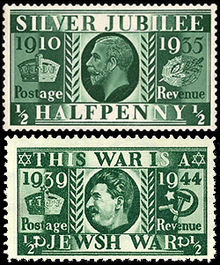 1935 Silver Jubilee stamp and its propaganda forgery
1935 Silver Jubilee stamp and its propaganda forgery
All known German falsifications are propaganda forgeries.[11] Forgeries of the Silver Jubilee issue of 1935 were falsified at the Sachsenhausen concentration camp by order of Heinrich Himmler during the war. The modifications included the insertion of Jewish and communist emblems, placement of Stalin's head, the inscription that was faulty ("This war is a Jewsh war") and the years altered to 1939-1944. A similar falsification concerned the coronation issue from 1937 in which Stalin's head appears, the star of David is present, as well as an inscription concerning the Tehran conference. A third forgery is different and affects the 1937 series with the head of King George VI. The alterations are very subtle affecting emblems. Six values of the series were falsified. In the short film "Adolph Burger's Historical Artifacts" Sachsenhausen survivor Burger shows examples of some of these stamps that he helped produce. He also describes this in greater detail in his book "The Devil's Workshop"
United States forgeries for Germany
The first stamps to be forged were the common 6 and 12 pfennig Hitler head stamps that were printed in Rome by the Office of Strategic Services in 1944. These stamps were applied to letters containing propaganda, marked with false postmarks (Wien 8, Wien 40, Hannover 1), and distributed by drops from air planes as Operation Cornflakes.
The US modified the 12 pfennig Hitler head stamp by the insertion of a death head and the inscription "Futsches Reich" (The Reich is gone) replaces "Deutsches Reich". Similarly, the Hitler block from 1937 was altered showing a death head, graves, and gallows; the inscription is "Deutsches Reich 1944". Also, postcards were forged.
Soviet forgeries for Germany
Soviet forgeries were limited to postcards with propaganda messages that had imprinted stamps.
British forgeries
Great Britain produced forgeries for Germany, France, Italy, Poland (Generalgouvernement), and French-Morocco during World War II.
Regarding Germany, the first forgery was the 12 pfennig Hindenburg head stamp, later followed by the 3,4,6, and 8 pfennig values, to distribute propaganda material in Germany. Other stamps such as the Hitler heads and some fieldpost stamps may not have reached circulation.
A major effort was the production of propaganda stamps. The Hitler head stamp was modified to depict Heinrich Himmler
Another propaganda forgery concerns the 1943 Hitler putsch stamp that shows General Witzleben (a participant in the July 20, 1944 Hitler attentat) and is inscribed with "Gehängt am 8. August 1944" (Hanged on ..). Other forgeries affect the welfare stamps from 1938, and the 1944 Hitler putsch stamp.
Regarding France, Britain produced forgeries of the Iris series and of stamp depicting Marshal Philippe Pétain.
For Italy, Britain produced stamps of the Victor Emmanuel stamps, as well as propaganda stamps with Hitler and Mussolini inscribed "Due populi, un führer".
Stamps were produced in Great Britain for the Generalgouvernement and utilized by the Polish underground army to distribute propaganda material. The Hitler head stamp of the Generalgouvernement was modified to depict Hans Frank on the 20 groszy value. These stamps circulated in the postal system.
French-controlled Morocco received stamps forged by the British authorities that had overprints of "Deutsche Reichspost in Marokko" to create confusion and suggest an imminent German occupation. Few examples are known.
Cold war
West Berlin for the GDR
Between 1948 and 1954 the a group founded by Werner Hildebrandt produced anti-communist propaganda including stamps that were used in the postal system of the GDR. The first stamps to get modified were the 12 and 24 pfennig values of the series depicting the President of the GDR Wilhelm Pieck that showed a noose and the inscription "Undeutsche Undemokratische Diktatur" (un-German un-democratic dictatorship). Other changes were made to the stamps of the Five-Year-Plan. The group also modified production instructions to factories that caused economic damage.
Other types
Official reprints
Official reprints of stamps that are no longer valid for postage are usually produced by governments to meet a philatelic demand. Scott numbers 3 and 4 of the United States were produced in this way. This also happened with several early sets of the Peoples' Republic of China.
Remainders
Remainders are surplus stocks of legitimate postage stamps that have been put into the philatelic market after being demonetized. Among these are the later stamps of Nova Scotia, before it became a province of Canada, and the German inflationary period stamps. One effect of distributing large quantities of remaindered stamps to the public is that used stamps can be much more valuable than mint ones.
Bogus stamps
Bogus stamps are pretended, fictitious stamps which purport to be produced by an entity that exists and could have produced them, but didn't. A bogus stamp is not a forgery because it never really existed.[12] It does not even resemble anything that the entity did produce, and only rarely are any of these labels ever shipped to the place that is shown as issuing them. The term also refers to an actual stamp which bears the sham addition of an unauthorized surcharge or overprint.[12]
They are generally issued to deceive collectors. Among these are the issues for South Moluccas when Henry Stolow printed the Maluku Selatan stamps, and the uninhabited Scottish island of Staffa. The 1923 famine relief stamps of Azerbaijan were bogus, but these too were also subsequently forged.[13]
Fantasies
Fantasies claim to be issued by places that don't even exist. One of the most famous of these were "King" Charles-Marie David de Mayréna's for Sedang.[14] The stamps of New Atlantis required the construction of a bamboo raft that would be floated in the Atlantic as the country.[15]
Local stamps
Local stamps are usually intended to serve a local purpose, and are not necessarily fraudulent. Thus we have in relation to the Great Britain: "... there were two local entities that 'performed much in the way of postal service ... Herm and Lundy.' Those two, it would seem, are considered thoroughly legitimate." [16] The legitimacy arises from the fact that these islands did not have official post offices, and a private service needed to be established to transport mail to the mainland. More often, however, a person should be wary of local issues which find a market with tourists and unwary collectors.
Cinderellas
Cinderellas is a broad term for just about anything that looks like a postage stamp but isn't. While the term includes bogus stamps and fantasies, it also includes many fund raising labels, Christmas seals, and other stickers that were produced for legitimate purposes.
Methods
Entire forgeries
This is the most obvious way of producing forgeries, and as such is self-evident. The forger starts from scratch, and completely re-engraves the plate. It is virtually impossible to produce a new engraving that will be identical to the original. Thus, in the earliest set of Hong Kong stamps the forgeries can be distinguished by counting the number of shading lines in the background. Some early Japanese forgeries are distinguished by remembering that the chrysanthemum crest in the stamp should always have 16 petals.
Modern electronic techniques would appear to make things easier for the forger, but understanding how different printing methods work can be very helpful in discovering these forgeries. Recently Peter Winter from Germany used modern technology to produce convincing reproductions which were then sold on as genuine by unscrupulous persons.
Forged overprints
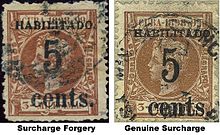 Forged overprint on 1899 Puerto Principe, Cuba, provisional stamp alongside a genuine surcharge. While the relative spacings of the three elements of the surcharge are roughly the same as on the genuine stamp, note, however, the differences in the crossbar on the "t" and the cap of the "5", together with the crispness of the lettering.
Forged overprint on 1899 Puerto Principe, Cuba, provisional stamp alongside a genuine surcharge. While the relative spacings of the three elements of the surcharge are roughly the same as on the genuine stamp, note, however, the differences in the crossbar on the "t" and the cap of the "5", together with the crispness of the lettering.
One would imagine that overprints should be easier for a forger to falsify. It is just a simple matter of applying a few letters to a stamp with black ink. Paying attention to detail can reward a philatelic sleuth. The stamps of Bangkok from the 1880s were produced by overprinting each stamp a single letter "B" on stamps of the Straits Settlements. Some of these overprints are bogus because they are on underlying stamps that were never known to have been issued with that overprint. Forgeries can be discovered by examining the relative heights of the two loops of the B.[17]
Another example, from New Zealand, is four stamps overprinted for an industrial exhibition held in Auckland in 1913. The accompanying image shows genuine overprints, and forged overprints from an internet auction. A New Zealand dealer prices a set of postally used stamps with genuine overprints at NZD 1600, while the same four stamps, postally used without the overprint, are priced at NZD 8.[18] This indicates the potentially lucrative payoff for forgers.
In another example the 1948 Gandhi stamps of India were overprinted with the single word "SERVICE" to produce a stamp for official government use. The key to knowing the difference between the two is based on recognizing the difference between a typographed and a lithographed overprint. The former will leave an impression in the paper which can be detected by looking at the back of the stamp.
Reperforating
In some cases a valuable and a common variety of a stamp differ only by the presence or size of the perforations. Thus perforations are cut off to make a stamp appear imperforate, or new perforations are carefully cut into the stamp. When considering this possibility it is important to consider whether the stamp has been made smaller than it should be, or whether the perforations come together at the corners as they should with a comb or harrow perforated stamp.
Regumming
Although this is controversial, many collectors believe that a mint stamp is more valuable when the gum has been undisturbed. There are many fakers who are happy to accommodate them so that they can receive a premium price for a mint-never-hinged stamp. Not all expertisers are willing to give an opinion on this kind of fakery. If you suspect that a stamp has been regummed look to see if the gum has the right colour. Some stamps should have scoring lines which seem to be defects, but are really there to prevent the sheet of stamps from curling. Examine the perforations closely; genuine gum is normally put on stamps before they are perforated so that gum that flows into the perforations may be a sign of being faked. There are situations where the original gum should have been washed off; bright fresh gum on the 1933 WIPA souvenir sheet of Austria would probably be false since the acidic nature of the original gum would cause the paper to deteriorate.
It is possible to test for regumming by running your finger along the perforations. On a genuinely gummed stamp, the perforations will feel soft; on a regummed stamp, the perforations will feel rough to the touch, indicating that gum has been placed on the stamp after perforation.[citation needed]
Repairs
In some cases the value of a damaged stamp can be enhanced by repairing the damage. This is also considered faking. Sometimes this can be detected by making sure that the right kind of paper is on the back of the stamp, or by putting the stamp in watermark fluid.
Colour changes
The colour of a stamp can be changed by exposing the stamp to various chemicals, or by leaving it out in bright sunlight. Carefully applied chemicals can also be used to remove specific colours to produce "rare" missing colour varieties.
False postmarks
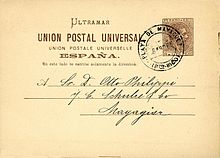 A postal card canceled on "8 April 1885". This was thought to be a genuine (and quite valuable) used card until a noted collector of Puerto Rican postal stationery noticed that he had other cards postmarked Mayagüez and addressed to the same recipient who lived in Mayagüez, who he knew to be a representative of the Senf brothers, stamp dealers in Leipzig, Germany. The other cards were dated 8 April 1887 (for the 1887 card), and 8 April 1893 (for the 1893 card). This led him to the conclusion that the recipient addressed them to himself and had a sympathetic or complicit postal clerk fraudulently back date the year to match the card's date of origin. He probably then sent the uncirculated, but postmarked, cards to the Senf brothers who sold them to collectors.[19]
A postal card canceled on "8 April 1885". This was thought to be a genuine (and quite valuable) used card until a noted collector of Puerto Rican postal stationery noticed that he had other cards postmarked Mayagüez and addressed to the same recipient who lived in Mayagüez, who he knew to be a representative of the Senf brothers, stamp dealers in Leipzig, Germany. The other cards were dated 8 April 1887 (for the 1887 card), and 8 April 1893 (for the 1893 card). This led him to the conclusion that the recipient addressed them to himself and had a sympathetic or complicit postal clerk fraudulently back date the year to match the card's date of origin. He probably then sent the uncirculated, but postmarked, cards to the Senf brothers who sold them to collectors.[19]
For a beginner it appears self-evident that a bright new unused postage stamp is worth more than one that has been soiled by a cancellation. This is not always true. There are many instances of stamps that have been produced in large quantities, but where comparatively very small numbers have done postage service. Huge quantities of mint stamps can be left over after a bout of inflation, a political overthrow or loss of a war. In some cases a genuine stamp can have a fake cancellation applied to make it appear to be a rare, and valuable postally used example. To identify these fakes it is important to understand the postmarks that were in use at the time, and to make sure that the date is consistent with proper usage, or that the cancelling post office existed during the time the stamp was in proper use.
It is also important to know that not all cancellations are postal. Some countries have inscribed their stamps "Postage and Revenue". Some very high face values on such stamps could not reasonably have been used for postage, thus making any kind of proper postal usage exceedingly rare. More commonly these high face values were for fiscal usages to indicate the payment of taxes on real estate or corporate shares. While such cancellations are not fakes, they can easily be misrepresented to the unwary as the more valuable postal cancellations. Rainer Blüm was sentenced recently in a high-profile German legal case for forgery of postmarks to increase the value of stamps.
Cancelled-to-order
Main article: Cancelled-to-orderTechnically "C.T.O."s are not fakes since they have been cancelled by the stamp issuing authority. Many of these are easily identified because while they have been postmarked they still retain their original gum. Some postal authorities cancel them and sell them at a considerable discount to the philatelic community. The authorities can do that profitably because they no longer need to provide the postal services that the stamps were meant to pay for. Many collectors are more interested in stamps that have been correctly used, and the corresponding used stamp may often be worth more than a mint stamp. Authorities who do this tend to use the same canceller for all C.T.O.s, and apply it very neatly in the corner of four stamps at one time.
See also
- Illegal stamps
- List of stamp forgers
- Philatelic expertisation
- Russian philatelic forgeries
References and sources
- Footnotes
- ^ Tom Horn, "Beware of Problem Areas", in American Philatelist vol. 118, No. 1, p. 60, January 2004
- ^ Matthew Karanian, "The Karabagh Story", in American Philatelist, vol. 114, No. 3, March 2000, p.267
- ^ Thornton Lewes & Edward Pemberton, Forged Stamps: How to Detect Them , Edinburgh, 1863 (1979 republication in Early Forged Stamps Detector, New York), pp. 7-8.
- ^ The Stamp Collector's Magazine. 1. London: E. Marlborough. 1863-05-01. pp. 61. http://books.google.com/?id=6awEAAAAQAAJ&pg=PA61.
- ^ The Stamp Collector's Magazine. 1. London: E. Marlborough. 1864-05-01. pp. 67–69. http://books.google.com/?id=6awEAAAAQAAJ&pg=RA1-PA67.
- ^ "Postal Imposters" in Detecting the Truth: Fakes, Forgeries and Trickery, a virtual museum exhibition at Library and Archives Canada
- ^ a b c d Mackay, James. The Guinness Book of Stamps Facts & Feats. 1st edition. London: Guinness Superlatives Limited, 1982, p.150. ISBN 0851122418
- ^ See, e.g., James M. Chemi, The Yucatan Affair - The Work of Raoul C. De Thuin, Philatelic Counterfeiter (2d ed. American Philatelic Society, State College, PA 1980) p. 149.
- ^ See, e.g., Roberto Liera Gutiérrez, Characterísticas de Algunas Falsificaciones de Timbres de México p. 10 (Mexico sold genuine cancellation devices which were later used on forgeries.
- ^ Examples retrieved 04-12-2008
- ^ Gustav Schenk. The Romance of the Postage Stamp. Doubleday & C0, Garden City, NY (1959), p183ff
- ^ a b Bennett, Russell and Watson, James; Philatelic Terms Illustrated, Stanley Gibbons Publications, London (1978).
- ^ L. N. and M. Williams, Cinderella Stamps, London, Heinemann, 1970, p. 81.
- ^ Williams (1970), p. 2.
- ^ Williams (1970), p. 109.
- ^ Richard M. Langworth, "Herm and Its Locals", American Philatelist, Vol. 95., No. 11, Nov. 1981, p. 1009
- ^ Robson Lowe, The Encyclopædia of British Empire Postage Stamps, 1775-1950, London, Robson Lowe Ltd., 1951, pp. 380-1
- ^ "Auckland City Stamps 2008 Catalogue Page 5". Archived from the original on 2008-05-22. http://web.archive.org/web/20080522081834/http://www.nzstamps.com/Cat_pages/Cat05.html. Retrieved 2008-08-30.
- ^ Mitchell, Byron, editor of the Puerto Rico section of Postal Cards of Spanish Colonial Cuba, Philippines and Puerto Rico, Robert Littrell, editor, UPSS (2010)
- Sources
- Werner M. Bohne, "Caveat Emptor: Detecting German Forgeries", in American Philatelist, Vol. 96, No. 12, December 1982, pp. 1097–1103. Includes detection techniques.
- Robert Brisco Earée, Album Weeds; or, How to Detect Forged Stamps, 2nd edition, London, Stanley Gibbons, 1892. A classic for identifying early forgeries.
- Stephen G. Esrati, "When Expertzers Disagree", in American Philatelist, Vol. 96, No. 5, May 1982, pp. 439–443, 467. Even the experts can be wrong.
- Fernand Serrane, Vade-mecum du spécialiste-expert en timbres-poste, in two volumes: vol.1, "Europe", Nice, Imprimerie de l'Éclaireur, 1927; vol.2, "Hors d'Europe", Bergerac, Imprimerie générale du sud-ouest, 1929. A one volume translation of this was published in 1998 as The Serrane Guide, Stamp Forgeries of the World to 1926, American Philatelic Society, Pennsylvania (1998).
External links
- Propaganda and Espionage Philately by SGM Herbert A. Friedman (Ret.)
- Detecting the Truth: Fakes, Forgeries and Trickery. Library and Archives Canada.
- Propaganda stamps showing originals and forgeries in pictures, retrieved 04-12-2008
- Fakes and forgeries: cull them or collect them? by Rick Miller, Linn's Stamp News
Categories:- Philatelic fakes and forgeries
- Philatelic terminology
Wikimedia Foundation. 2010.

